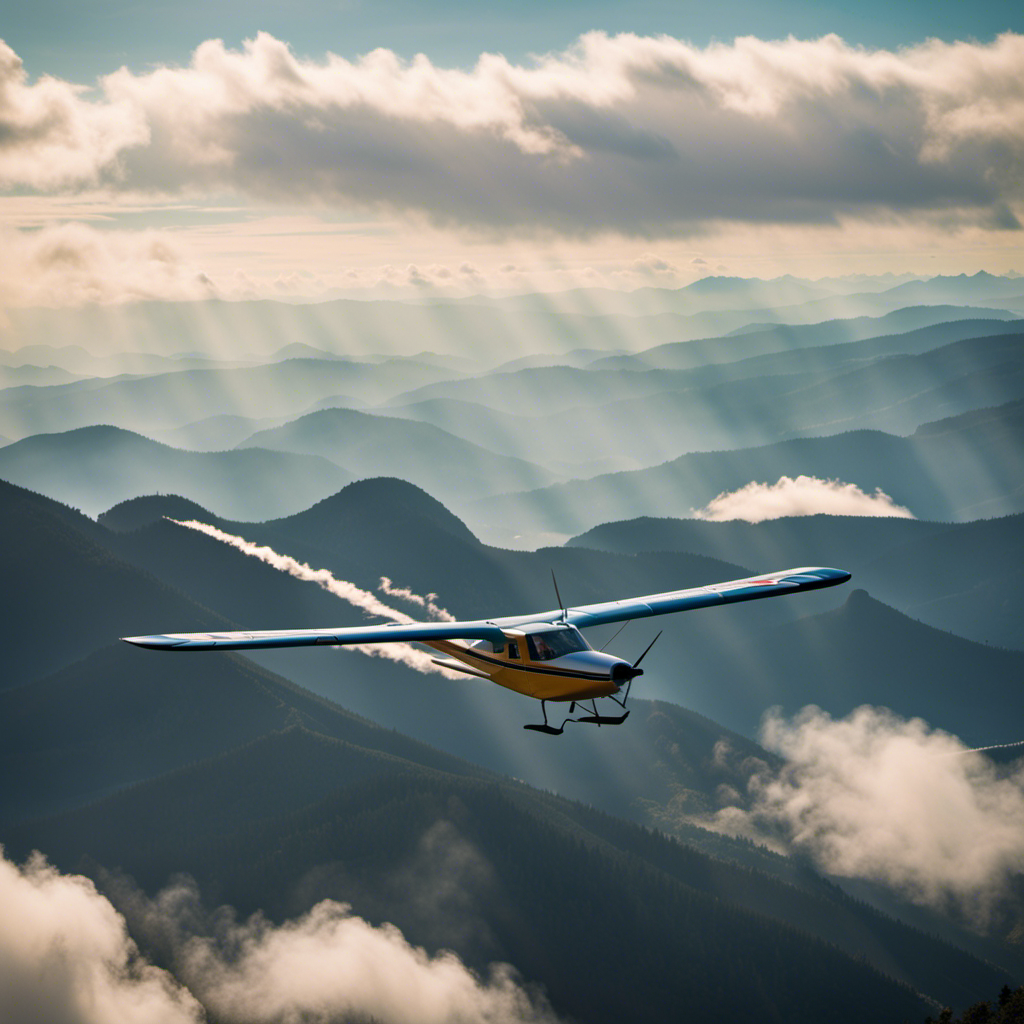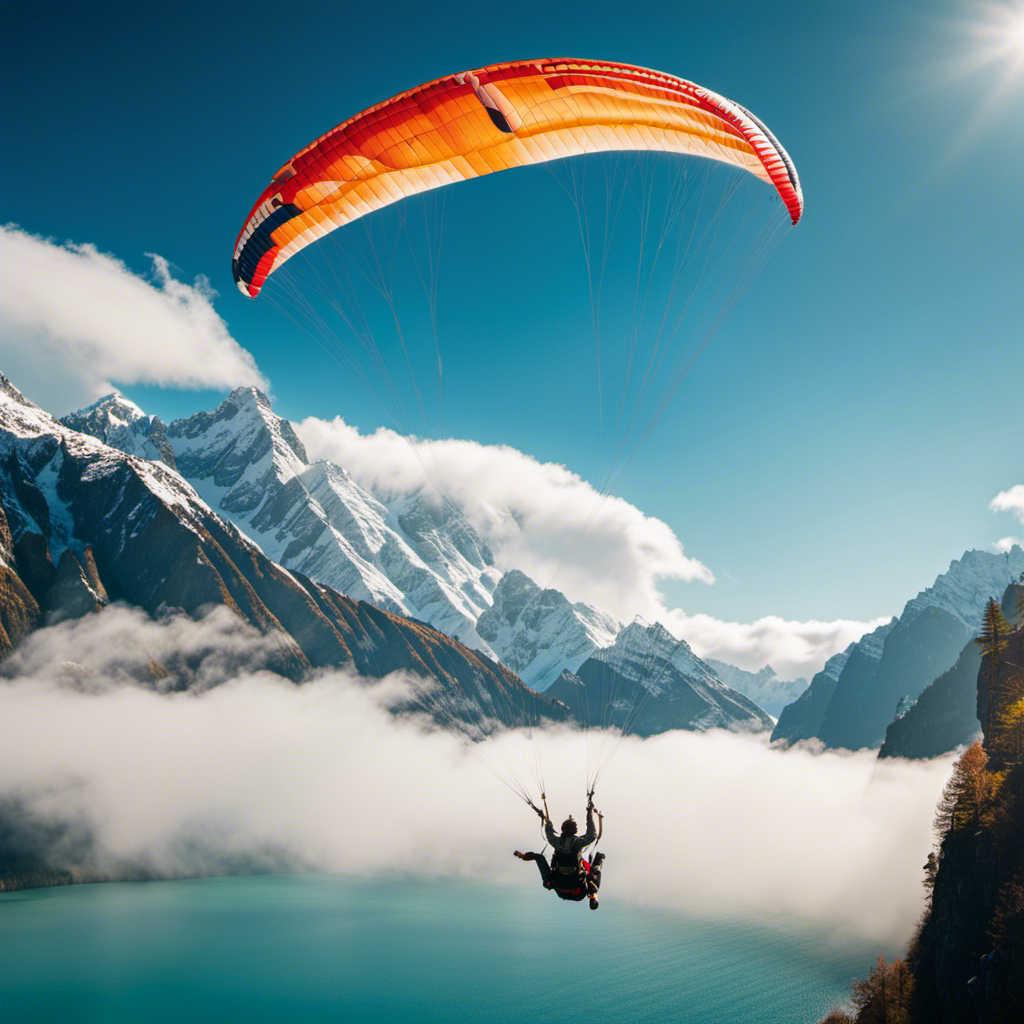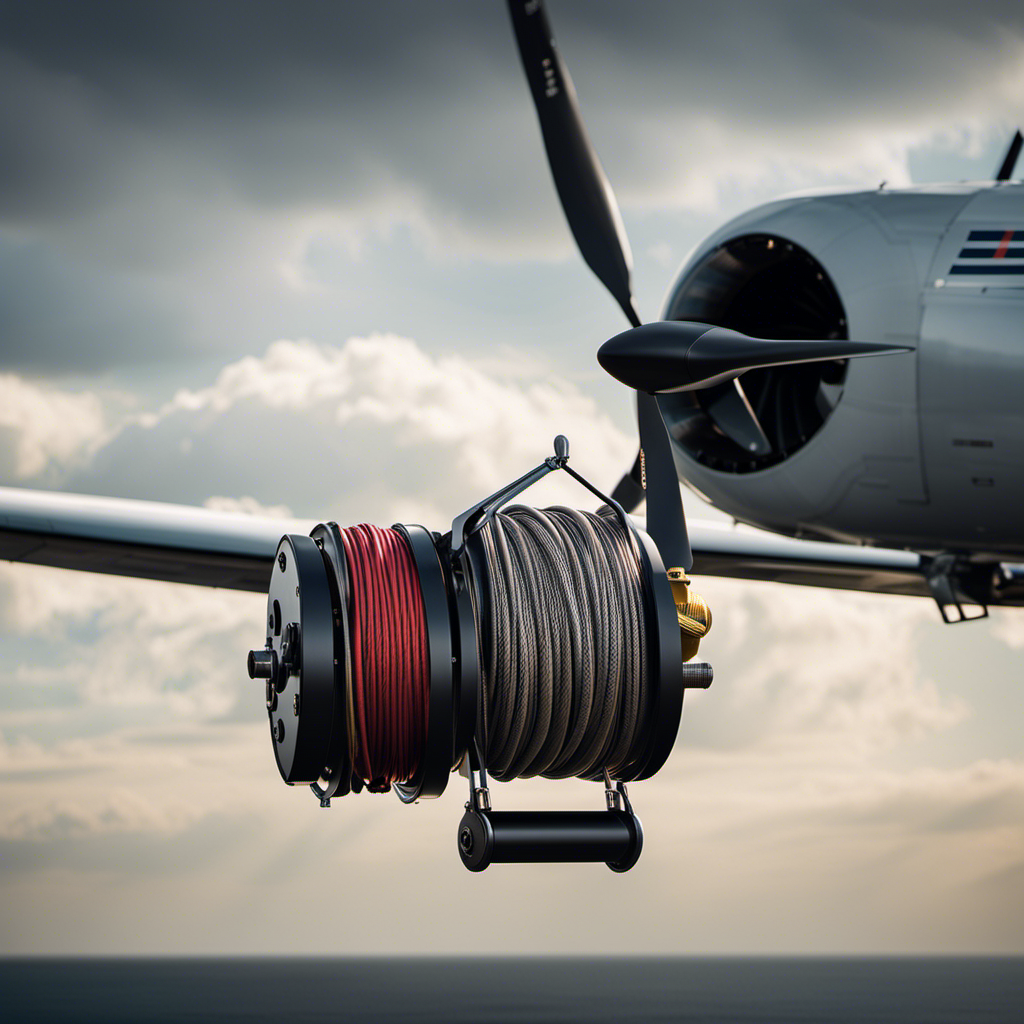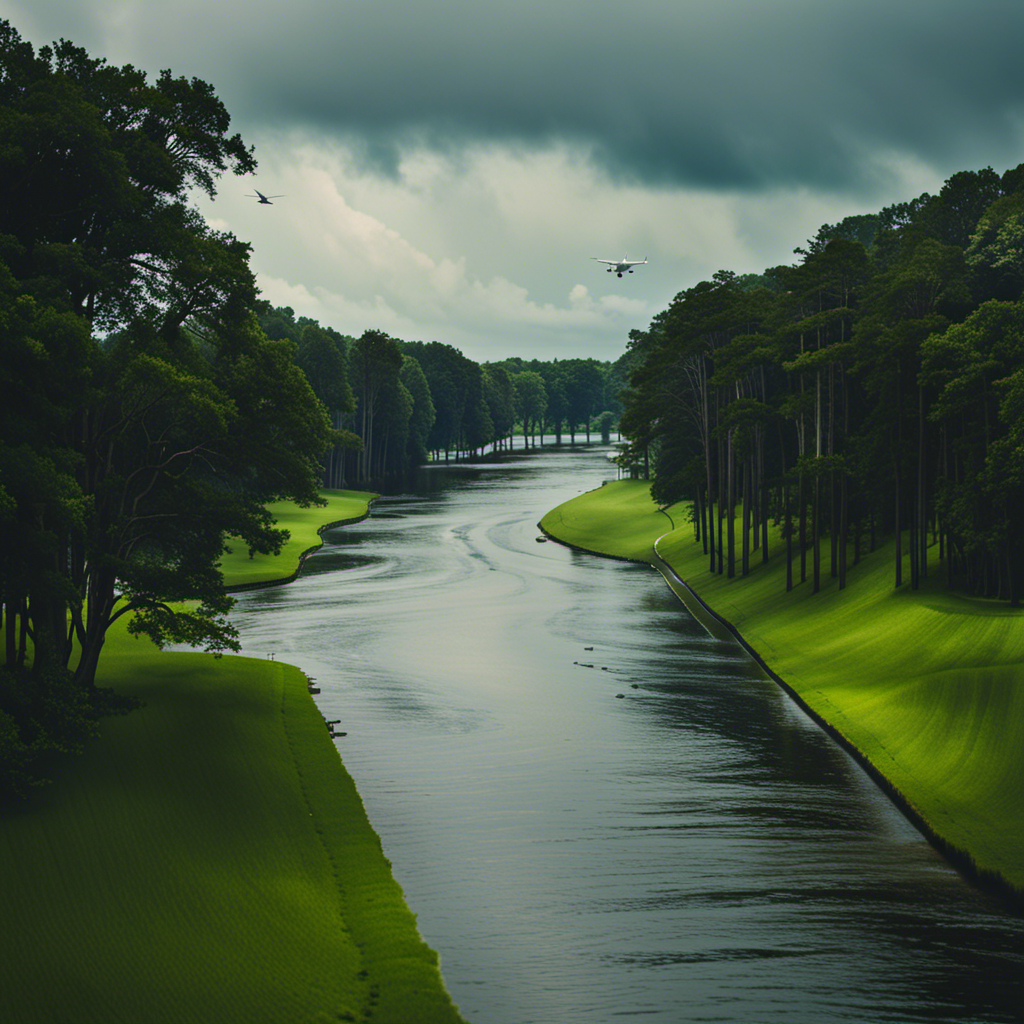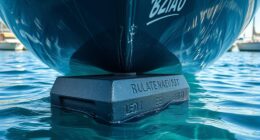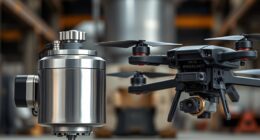While soaring through the sky, my glider effortlessly maneuvers through the air currents, defying gravity and reaching impressive heights.
Have you ever wondered just how high a glider can fly?
In this article, I will delve into the intricacies of gliding and explore the factors that determine a glider’s altitude.
From the records set by daring pilots to the techniques used to reach soaring heights, join me on this journey as we uncover the exhilarating world of high altitude gliding.
Key Takeaways
- Gliders rely on lift generated by their wings to stay airborne and can soar for extended periods.
- Factors such as wingspan, weight, glide ratio, and airfoil design affect a glider’s ability to generate lift and reach higher altitudes.
- Favorable weather conditions like thermals and ridge lift can enhance glider performance and altitude.
- Glider altitude is typically below 18,000 feet, while commercial airlines reach higher altitudes using jet engines.
The Basics of Gliding
The glider can reach impressive altitudes when soaring on rising air currents. Gliding is a fascinating sport that relies on the physics behind flight to stay airborne for extended periods.
Gliders are designed to take advantage of lift, which is generated by the interaction between the glider and the surrounding air. This lift is created when the glider’s wings generate an upward force that counteracts the downward force of gravity.
The history of glider flight dates back to the late 19th century, with pioneers such as Otto Lilienthal and the Wright brothers making significant contributions. Understanding the principles of aerodynamics and mastering the art of reading the air currents are crucial skills for glider pilots.
Transitioning to the next section, let us explore the factors that determine glider altitude.
The Factors that Determine Glider Altitude
One of the factors that determines how far a glider can go up into the air is its wingspan. A glider with a longer wingspan can generate more lift, allowing it to achieve higher altitudes.
However, glider performance is not solely determined by wingspan. There are several other factors that come into play, including:
- Weight: A lighter glider will have a better climb rate and can reach higher altitudes.
- Glide ratio: Gliders with higher glide ratios can maintain altitude for longer periods, allowing them to reach higher altitudes.
- Airfoil design: An efficient airfoil shape can maximize lift and minimize drag, enabling the glider to soar to greater heights.
- Pilot skill: A skilled pilot can exploit the glider’s performance capabilities and find optimal updrafts to gain altitude.
- Atmospheric conditions: Favorable weather conditions, such as thermals and ridge lift, can significantly enhance glider performance and altitude.
Understanding these factors is crucial for maximizing glider altitude.
Speaking of altitude, let’s now delve into the fascinating world of the altitude records in gliding.
The Altitude Records in Gliding
Let’s now explore the fascinating world of altitude records in gliding. Gliding competitions have witnessed incredible achievements in reaching great heights without the aid of an engine. Below is a table showcasing some of the notable altitude record holders in gliding:
| Altitude Record Holders | Altitude Achieved (meters) |
|---|---|
| Klaus Ohlmann | 15,460 |
| Steve Fossett | 15,447 |
| Einar Enevoldson | 15,445 |
| Jim Payne | 14,938 |
These glider pilots have pushed the boundaries of human flight, demonstrating remarkable skill and determination. Their achievements serve as inspiration for future aviators to continue pushing the limits of what is possible in gliding. However, despite these remarkable records, there are limitations on glider altitude that we must consider and explore further.
Limitations on Glider Altitude
Despite the challenges faced, glider pilots are constantly striving to push the boundaries of altitude in order to achieve new records.
Glider performance and atmospheric conditions play a crucial role in determining the maximum altitude a glider can reach. Glider performance is influenced by factors such as wing design, weight, and aerodynamic efficiency. These factors impact the glider’s ability to generate lift and maintain altitude.
Atmospheric conditions, including temperature, pressure, and wind patterns, also affect glider performance. High temperatures can reduce air density, limiting the glider’s lift production. Strong winds can create turbulence, making it difficult for a glider to maintain altitude.
Understanding and adapting to these limitations is essential for glider pilots who aim to fly at high altitudes. By employing specific high altitude glider flying techniques, pilots can overcome these challenges and achieve their altitude goals.
High Altitude Glider Flying Techniques
When it comes to high altitude glider flying, there are two key techniques that can be utilized.
Mountain wave lift occurs when the wind encounters a mountain range and creates standing waves on the lee side. Gliders can ride these waves and gain altitude.
Thermal lift, on the other hand, is created by the heating of the Earth’s surface. This causes pockets of warm air to rise, providing gliders with opportunities to soar to higher altitudes.
Understanding and effectively utilizing these two types of lift is crucial for glider pilots. It allows them to maximize their altitude and extend their flight time.
Utilizing Mountain Wave Lift
You can use mountain wave lift to fly a glider at higher altitudes. Mountain wave dynamics play a crucial role in glider performance, allowing us to harness the power of these atmospheric waves to soar to impressive heights.
Here are three key factors to consider when utilizing mountain wave lift:
-
Wind Direction: It’s essential to identify the direction of the prevailing winds and position the glider accordingly to intercept the rising airwaves.
-
Wave Barriers: Mountains act as barriers, causing the airflow to rise on the windward side and descend on the leeward side. Identifying these wave barriers is crucial for finding optimal lift.
-
Wave Strength: The strength of the mountain waves can vary depending on weather conditions. Monitoring wind speed and turbulence levels will help determine the suitability and safety of utilizing the mountain wave lift.
By taking advantage of these mountain wave dynamics, glider pilots can maximize their altitude and extend their flight time.
Transitioning from mountain wave lift, let’s explore how we can further enhance glider performance by harnessing thermal lift.
Taking Advantage of Thermal Lift
Transition: Now that we’ve explored the benefits of utilizing mountain wave lift, let’s delve into another method of gaining altitude in a glider: thermal soaring.
In thermal soaring, glider pilots harness the power of rising columns of warm air, known as thermals, to maximize lift and gain altitude. Thermals are created when the sun heats the ground, causing the air near the surface to become warmer and less dense. As this warm air rises, it forms a thermal that can lift a glider upwards.
To make the most of thermal lift, glider pilots must skillfully navigate the sky, constantly searching for areas of rising air. They rely on visual cues, such as cumulus clouds and the behavior of other birds, to identify thermals. Once a thermal is found, pilots circle within it, gradually climbing higher and higher.
| Technique | Description | Benefit |
|---|---|---|
| Thermal Sniffing | Flying low and slow, closely monitoring the air temperature and wind direction for signs of thermals | Increases the chances of finding and entering a thermal |
| Cloud Street Follow | Tracking and flying along lines of cumulus clouds, which often indicate the presence of thermals | Enables pilots to maximize lift and stay within thermals for longer periods |
| Centering | Circling within a thermal using precise bank angles and control inputs | Allows pilots to climb higher within the thermal and gain more altitude |
Safety Considerations at High Altitudes
At high altitudes, it’s crucial to consider safety factors when flying a glider. One of the key concerns is the availability of high altitude oxygen. As you ascend, the air becomes thinner, and the oxygen levels decrease significantly, leading to hypoxia. To mitigate this risk, glider pilots must use supplemental oxygen systems to ensure they receive enough oxygen for safe operation.
Additionally, emergency procedures are of utmost importance when flying at high altitudes. In the event of an emergency, such as a sudden loss of altitude or a structural failure, glider pilots must be well-trained and prepared to execute the appropriate emergency procedures swiftly and efficiently. Safety is paramount in glider flying, especially at high altitudes where the risks are amplified.
Transition to the subsequent section about ‘glider altitude vs. powered aircraft altitude’:
Understanding the differences in altitude capabilities between gliders and powered aircraft is essential for safe and efficient flight.
Glider Altitude vs. Powered Aircraft Altitude
When comparing glider altitude with that of commercial airlines, there are significant differences to consider.
While commercial aircraft can reach altitudes of 35,000 feet or more, gliders typically operate at much lower altitudes, typically below 18,000 feet.
These altitude differences are due to the varying capabilities and regulations governing each type of aircraft.
Commercial airlines must adhere to strict altitude regulations and restrictions set by aviation authorities, whereas gliders have more flexibility in their altitude operations, allowing for a unique flying experience.
Comparison with Commercial Airlines
Commercial airlines can reach altitudes that are much higher than those of gliders. Here is a comparison of altitudes and fuel efficiency between commercial airlines and gliders:
-
Altitude Comparison:
- Gliders typically fly at altitudes between 3,000 to 18,000 feet above ground level.
- Commercial airlines can soar to altitudes ranging from 30,000 to 45,000 feet.
-
Fuel Efficiency:
- Gliders rely solely on thermal currents and updrafts for lift, requiring no fuel consumption.
- Commercial airlines, on the other hand, use jet engines that consume a significant amount of fuel to maintain flight at high altitudes.
The stark difference in altitude capabilities between these aircraft is due to the design and purpose of each. Gliders prioritize soaring at lower altitudes while maximizing fuel efficiency, whereas commercial airlines operate at higher altitudes to optimize speed and efficiency in long-distance travel.
Understanding these altitude differences sets the stage for exploring the contrasting regulations and restrictions faced by gliders and commercial airlines.
Differences in Altitude Regulations and Restrictions
The altitude regulations and restrictions for gliders are significantly different from those for commercial airlines. Gliders operate under specific altitude regulations and airspace restrictions that are tailored to their unique characteristics and capabilities. Unlike commercial airlines, which typically fly at higher altitudes to take advantage of the more favorable atmospheric conditions, gliders are limited to lower altitudes due to their reliance on thermal currents and updrafts for sustained flight. These altitude regulations ensure the safety of glider pilots and prevent conflicts with other aircraft operating in the same airspace.
Additionally, gliders are subject to specific airspace restrictions that designate areas where gliding is permitted and outline the rules and procedures for entering and exiting these areas. These regulations and restrictions are essential for maintaining the safety and orderliness of glider operations in the airspace.
Transitioning into the future of high altitude gliding, advancements in technology and design are opening up new possibilities for glider pilots to reach higher altitudes and explore previously uncharted territories.
The Future of High Altitude Gliding
You can expect advancements in technology to allow gliders to reach even higher altitudes in the future. With ongoing research and development, glider manufacturers are constantly exploring new ways to improve performance and maximize altitude capabilities. Technological innovations such as lighter materials, more efficient wing designs, and improved propulsion systems are paving the way for gliders to soar to unprecedented heights.
To illustrate the potential for future advancements in high altitude gliding, consider the following table:
| Technological Innovations | Potential Impact |
|---|---|
| Carbon fiber construction | Increased strength and reduced weight |
| Advanced aerodynamics | Enhanced lift and reduced drag |
| Electric propulsion | Extended range and improved climb rates |
| GPS navigation systems | Enhanced navigation and safety |
Each of these advancements contributes to the overall goal of allowing gliders to fly higher and stay aloft for longer durations. As technology continues to evolve, the possibilities for achieving new altitude records become even more exciting.
Transitioning to the subsequent section about ‘famous glider altitude records and achievements,’ it is fascinating to see how these advancements can push the boundaries of what is possible in the world of gliding.
Famous Glider Altitude Records and Achievements
Imagine reaching altitudes that were once thought to be impossible as you witness the remarkable glider altitude records and achievements that have been accomplished by skilled pilots throughout history. Here are three astounding examples:
-
The Perlan Project: In 2018, the Perlan II glider soared to an astonishing altitude of 76,124 feet, setting a new world record for glider flight. This remarkable achievement was made possible by utilizing stratospheric mountain waves to gain altitude.
-
The Airbus Perlan Mission II: In 2019, this ambitious project reached an altitude of 65,605 feet, surpassing the previous record set by Perlan I in 2006. The glider’s innovative design and state-of-the-art technology allowed it to ascend to such heights.
-
The Hochosterwitz Glider: In 1961, Austrian pilot Walter Binder flew the Hochosterwitz glider to an incredible altitude of 49,009 feet. This record-breaking flight showcased the potential of gliders to reach altitudes comparable to some powered aircraft.
These famous glider altitude records highlight the extraordinary capabilities of these aircraft, proving that they can reach heights previously unimaginable. In comparison to powered aircraft, gliders have demonstrated their ability to achieve impressive altitudes without the use of engines.
Soaring through the skies, gliders offer a unique and thrilling experience that cannot be matched. The thrill and beauty of glider flight is truly unparalleled, as we will explore in the next section.
Conclusion: The Thrill and Beauty of Glider Flight
Experience the unmatched exhilaration and breathtaking aesthetics of glider flight as you witness the thrill and beauty that can only be found in the skies.
Glider flight challenges are not for the faint of heart. The absence of an engine means relying solely on thermal currents and wind patterns to stay aloft. This requires precise navigation and skillful maneuvering to maintain altitude and avoid sinking air.
But the rewards are worth it. Glider flight offers a unique perspective for aerial photography, allowing for stunning shots of landscapes, cityscapes, and even wildlife. With the ability to soar silently through the air, gliders provide an ideal platform for capturing images from above.
The combination of the challenges and the opportunity for stunning visuals make glider flight an unparalleled experience.
Frequently Asked Questions
How long can a glider stay at high altitudes?
A glider’s endurance at high altitudes is determined by its design and performance capabilities. Factors such as aerodynamics, glide ratio, and energy management systems play a crucial role in maximizing glider endurance and maintaining sustained flight at high altitudes.
What are the risks of flying at high altitudes in a glider?
Flying at high altitudes in a glider poses several risks and challenges. These include reduced oxygen levels, extreme temperatures, strong winds, and potential loss of control. Pilots must be prepared and equipped to handle these conditions to ensure a safe flight.
Are there any special equipment or modifications required for high altitude gliding?
When engaging in high altitude gliding, special equipment and modifications are essential. These include oxygen systems, pressurized cockpits, and enhanced insulation. These additions ensure safety and comfort while soaring at extreme heights.
How does weather affect glider altitude?
Weather conditions play a crucial role in determining the altitude a glider can reach. The presence of thermal currents, which are created by temperature differences in the atmosphere, can provide uplift and allow gliders to soar to higher altitudes.
What are the main challenges faced by glider pilots when flying at high altitudes?
Navigating high altitudes presents glider pilots with numerous challenges. These include maintaining airspeed, coping with reduced oxygen levels, and handling turbulent conditions. Techniques such as proper training, oxygen supplementation, and efficient energy management are crucial for safe and successful flights.
Conclusion
In conclusion, glider flight is a captivating pursuit that allows one to soar to great heights and witness the world from a unique perspective. The thrill of climbing higher and higher, like a bird reaching for the clouds, is an exhilarating experience that only gliding can provide.
While there are limitations to how high a glider can fly, the future holds potential for even greater altitudes. With each altitude record broken, glider pilots continue to push the boundaries of what is possible in the world of aviation.
